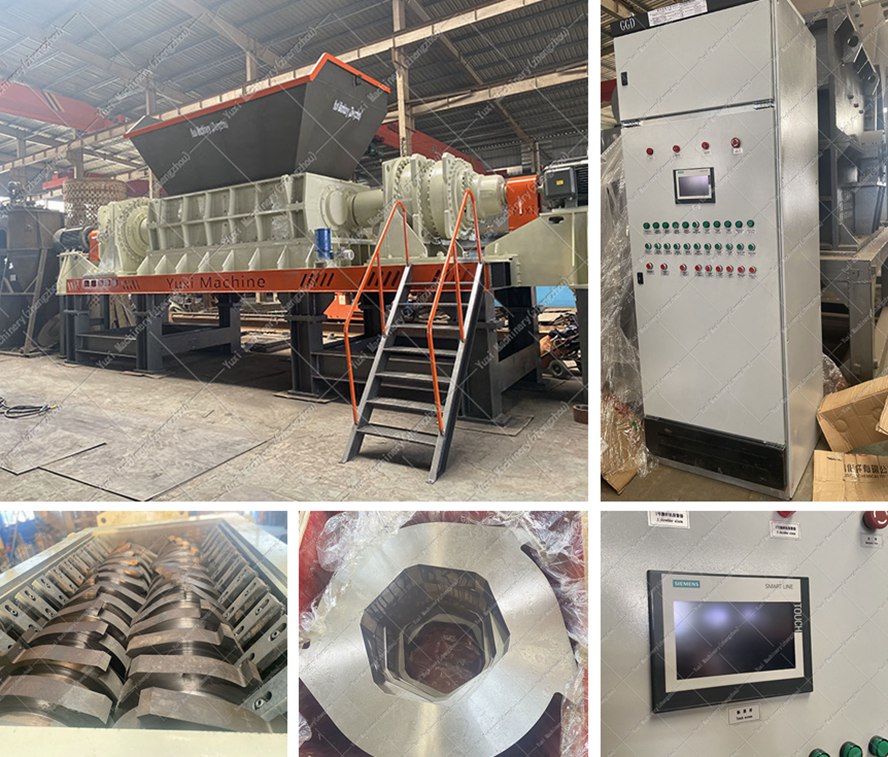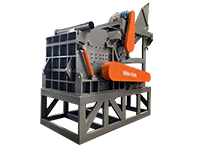In the daily operations of manufacturing, construction, and chemical industries, the disposal of waste paint buckets has always been a major challenge for enterprises. These metal containers not only occupy a large amount of storage space, but the residual paint, solvents and other harmful substances may also cause soil and water pollution. Improper disposal may also lead to severe environmental penalties. As a targeted waste treatment equipment, paint bucket shredders have become the core equipment for enterprises to realize the resource utilization of waste due to their high efficiency, safety and environmental protection characteristics. This article will deeply discuss the working principle, core advantages, technical details and application points of paint bucket shredders, and comprehensively analyze their key role in industrial waste disposal.
Understanding Paint Bucket Shredders
Paint bucket shredders are heavy-duty equipment specially designed for the crushing and recycling of metal containers. They mainly target 10-20 liter standard paint buckets, 200 liter large iron buckets and various waste metal packaging containers, realizing rapid crushing, volume reduction and material separation through mechanical force.
Working Principle: The equipment adopts a dual-shaft shear crushing structure. The motor drives high-strength alloy steel blades to rotate at high speed, and decomposes the metal bucket into uniform fragments of 50-100mm through the combined action of shearing, extrusion and tearing. The blades are equipped with a hydraulic-driven gap adjustment device, which can adjust the discharge size according to the processing needs and adapt to different recycling scenarios. The machine body is equipped with an overload protection system, which automatically shuts down when encountering hard impurities to avoid equipment damage.

Core Advantages:
• Efficient Processing: A single equipment can process 800-2000 standard paint buckets per hour, and the processing efficiency is more than 30 times that of manual disassembly, which greatly shortens the waste turnover cycle.
• Safety and Environmental Protection: The fully enclosed machine body design combined with a pulse dust removal system can control the dust concentration below 0.5mg/m³. It has a built-in explosion-proof device and waste liquid collection tank to prevent the leakage of residual harmful substances.
• Cost Saving: The density of crushed metal fragments is increased by 3-5 times, the transportation cost is reduced by more than 60%, and the recycled waste metal can be directly sold to smelters to form secondary income.
• Compliant Operation: It meets the environmental protection requirements for industrial solid waste treatment, helps enterprises avoid the risk of illegal penalties, and contributes to the construction of a green production system.
Technical Parameters: The motor power of mainstream equipment is 15-75kW, and the processing capacity can be adjusted according to the model. The blade hardness reaches above HRC60, the service life exceeds 8000 hours, the machine body is welded with Q235B steel plate, and the protection level reaches IP54, which is suitable for harsh industrial environments.
Main Functions
Modern paint bucket shredders have been upgraded from a single crushing function to comprehensive equipment integrating crushing, volume reduction, separation and environmental protection treatment, meeting the needs of multi-scenario applications.
1. Instant Volume Reduction: It can compress a 10-liter paint bucket to 1/10 of its original volume and a 200-liter large iron bucket to 1/15 of its original volume, which greatly saves storage space and reduces stacking pressure.
2. Safe Disposal of Hazardous Waste: For barrels containing residual paint, the equipment is equipped with a preheating desorption device. The residual organic matter is volatilized by low-temperature heating and then treated by activated carbon adsorption. The waste liquid is centrally recovered through the bottom collection tank to realize the harmless treatment of hazardous waste.
3. Material Separation and Recycling: Integrating magnetic separation and eddy current separation systems, it automatically separates ferromagnetic metals and non-ferrous metals during the crushing process. The iron recovery rate can reach 99%, and the recovery rate of non-ferrous metals such as aluminum and stainless steel is more than 95%, which improves the purity of recycled materials.
4. Data Tracking and Compliance: Intelligent models are equipped with PLC control systems, which can real-time record processing capacity, discharge size, energy consumption and other data, generate compliance reports, support remote monitoring and fault early warning, and ensure the whole process of treatment is traceable.

Selection and Implementation
Selecting a suitable paint bucket shredder needs to combine the actual needs of the enterprise, comprehensively consider equipment performance, application scenarios and long-term operating costs, to ensure the equipment exerts maximum benefits.
Key Considerations:
• Processing Capacity: Select the equipment model according to the monthly output of waste buckets. Small enterprises can choose 15-22kW models, and large factories are advised to configure 37-75kW high-power equipment.
• Material Type: Ordinary blades can be used for thin steel plate buckets, wear-resistant alloy blades are required for thick-walled buckets or buckets containing impurities, and special shear blades need to be replaced for plastic paint buckets.
• Space and Layout: The equipment needs to reserve more than 1.5 meters of operating space. The feed inlet is recommended to be connected with a conveyor belt, and the discharge outlet can be connected with a silo or transport vehicle to optimize material flow.
• Budget and Operation: The initial investment of the equipment is between 80,000 and 300,000 US dollars. It is necessary to comprehensively consider long-term expenditures such as energy consumption (15-25 kWh per ton of waste processed) and blade replacement costs (about 2,000-5,000 US dollars per year).
• Compliance Requirements: Ensure that the equipment's dust emission, noise (≤85dB) and other indicators meet local environmental standards, and prioritize models certified by CE and UL.
Implementation Steps:
1. Conduct a waste assessment, count the quantity, material and residual status of waste buckets, and clarify treatment goals and recycling needs.
2. Select the appropriate equipment model and supporting devices (such as dust removal and separation systems) according to site conditions and budget.
3. Plan the equipment installation location, design the feed, discharge and waste transportation routes to ensure smooth flow.
4. Conduct safety training for operators to master skills such as equipment start-stop, parameter adjustment and daily maintenance.
5. Build a data monitoring system, regularly analyze processing efficiency and energy consumption data, and optimize operation plans.
6. Establish a regular maintenance plan, clean the inside of the equipment weekly, check the blade wear monthly, and conduct comprehensive maintenance every quarter.
Frequently Asked Questions
Q: Can it handle other types of metal containers?
A: Yes, in addition to paint buckets, the equipment can also handle oil tanks, chemical buckets, metal packaging buckets, waste iron sheets and other containers. It only needs to adjust the blade gap and motor speed according to the material thickness.
Q: Is it safe to handle buckets containing residual paint?
A: Yes, special models are equipped with explosion-proof motors, flame-retardant liners and waste gas treatment systems, which can handle paint buckets with residual content below 5%. During operation, ensure good ventilation and wear protective equipment.
Q: What is the operating cost?
A: It mainly includes electricity fees (15-75 kWh per hour), blade replacement (1-2 times a year), maintenance fees and labor costs. The processing cost per ton is about 20-50 US dollars, which is much lower than the outsourcing processing fee.
Q: How much space is needed?
A: Small equipment covers an area of about 3×2 meters, and large equipment covers about 5×3 meters. During installation, it is necessary to reserve a feed inlet (height ≥1.2 meters) and a discharge transportation channel, and ensure that the distance between the equipment and the wall is ≥0.8 meters.
Q: How to ensure long-term efficient operation?
A: The key lies in regular maintenance: check the lubricating oil level daily, clean the waste channel weekly, grind the blades monthly, replace the hydraulic oil every quarter, and avoid feeding hard impurities such as stones and steel bars into the equipment.

By investing in suitable paint bucket shredders, enterprises can not only efficiently solve the problem of waste paint bucket disposal, but also realize resource recycling, reduce operating costs, and improve environmental compliance. Whether it is a small manufacturing workshop or a large industrial enterprise, paint bucket shredders are important equipment to promote sustainable development, providing efficient and environmentally friendly solutions for industrial waste disposal.
 Shredding Machine
Shredding Machine
 Waste Recycling Line
Waste Recycling Line
 Optional Equipment
Optional Equipment



